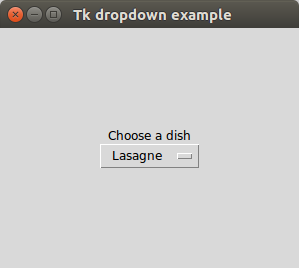Category: pro
Python hosting: Host, run, and code Python in the cloud!
Tk dropdown example
Tkinter supports dropdown menus. This is similar to your standard combobox on your operating system.
The widget is called OptionMenu and the parameters you need are: frame, tk variable and a dictionary with choices.
Related course:
Tkinter dropdown example
The example below creates a Tkinter window with a combobox.
from Tkinter import * import Tkinter as ttk from ttk import * root = Tk() root.title("Tk dropdown example") # Add a grid mainframe = Frame(root) mainframe.grid(column=0,row=0, sticky=(N,W,E,S) ) mainframe.columnconfigure(0, weight = 1) mainframe.rowconfigure(0, weight = 1) mainframe.pack(pady = 100, padx = 100) # Create a Tkinter variable tkvar = StringVar(root) # Dictionary with options choices = { 'Pizza','Lasagne','Fries','Fish','Potatoe'} tkvar.set('Pizza') # set the default option popupMenu = OptionMenu(mainframe, tkvar, *choices) Label(mainframe, text="Choose a dish").grid(row = 1, column = 1) popupMenu.grid(row = 2, column =1) # on change dropdown value def change_dropdown(*args): print( tkvar.get() ) # link function to change dropdown tkvar.trace('w', change_dropdown) root.mainloop() |
It starts by creating a Tk object and pass it to a tkinter frame created with Frame()
root = Tk() root.title("Tk dropdown example") mainframe = Frame(root) |
A grid is added to the frame which will hold the combo-box.
mainframe.grid(column=0,row=0, sticky=(N,W,E,S) ) mainframe.columnconfigure(0, weight = 1) mainframe.rowconfigure(0, weight = 1) mainframe.pack(pady = 100, padx = 100) |
The popup menu contains a list of options which is defined in the variable choices.
A Tkinter variable is created with the line:
tkvar = StringVar(root) |
The default value of the variable is set with the .set() method.
We create the Tkinter combobox with:
popupMenu = OptionMenu(mainframe, tkvar, *choices) |
And link the callback method change_dropdown to this combobox.

